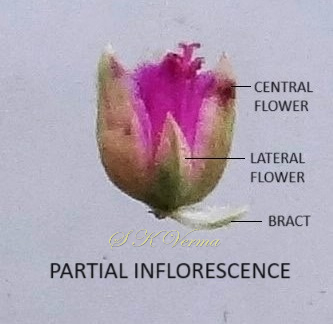DIGERA
Digera
Forssk., Fl. Aeg.- Arab. 65. 1775; Boiss., Fl. Or. 4: 994; 1879; Hook. f., Fl. Brit. India 4: 717. 1885; Schinz in E. & P. Pflanzenfam. ed. 2, 16c: 40. 1934; Fl. Pak. @ eFloras.org p. 21.
Annual herb, branches and leaves alternate; leaves entire. Flowers small, in long pedunculate, axillary, spike-like bracteate racemes, each bract subtending a very shortly pedunculate partial inflorescence consisting of a central fertile flower and 2 highly modified, sterile, unibracteolate lateral flowers. Tepals 4-5, the outer pair opposite and sheathing the remaining floral parts, the inner tepals much more delicate and hyaline. Stamens 4-5, free, without intermediate staminodes-like teeth, filaments filiform. Ovary with a single ovule, lateral on a curved funicle; style filiform; stigmas 2, divergent. Fruit a hard, indehiscent nutlet enclosed by a persistent perianth and falling together with sterile flowers and bracteoles.
One species
Digera muricata
Digera muricata
(L.) Mart., Nova Acta. Phys.- Med. Acad. Caes. Leop.- Carol. Nat. Cur. 13: 285. 1826; Sharma & Kachroo, Fl. Jammu Illustr. 2: t. 269. 1983; Kaur & Sharma, Fl. Sirmaur 542. 2004; Singh & Sharma, Fl. Chamba Dist. 595. 2006; keralaplants.in; Digera arvensis Forssk., Fl. Aegypt.- Arab. 65. 1775; Hook. f., Fl. Brit. Ind. 4: 717. 1885.
Annual herb, 20-60 cm tall, simple or with spreading or ascending flexuous branches from near the base. Stem and branches glabrous or sparingly pilose with paler ridges. Leaves alternate; leaf blade mostly ovate or ovate-lanceolate, 2-8 cm x 0.6-5 cm, glabrous, sometimes principal veins of lower surface spreading-hairy; base mostly rounded, margin entire, apex acute to acuminate; petiole 1-5 cm long, longer in lower leaves shortening upwards, pilose. Flowers glabrous, white tinged with pink or red (usually becoming greenish white in fruit), in long and slender or short and denser axillary racemes, long pedunculate up to 20 cm long, laxer below; inflorescence axis and peduncle sparingly hairy; bracts persistent, 1-2 mm long, ovate-oblong, acute, membranous with a green or brownish percurrent midrib, each subtending a very shortly pedunculate partial inflorescence of 3 flowers: central fertile and 2 lateral sterile. Central Flower: Tepals 5, subequal; outer 2 segments 3-4.5 mm long, ovate or oblong, navicular, membranous, 5-9-nerved, acute; inner 2-3 tepals slightly shorter, oblong, 1-2-nerved, pinkish, delicate, hyaline with a central darker vitta. Stamens 5, monoadelphous at base, pink, subequalling or shorter than style; filaments 2-2.5 mm and anthers 0.5 mm long. Ovary 1 mm long, glabrous, unilocular with one ovule; style ca. 2 mm long; stigmas 2, finally recurved. Lateral Flowers: Appressed, 1- bracteolate, bracteoles similar in form to bract; these flowers much reduced and increasingly so in the upper part of spike (sometimes absent); modified into accrescent, antler-shaped scales, scales with narrow lateral lobes. Fruit subglobose, slightly compressed, 2-2.5 mm, bluntly keeled along each side, furnished with 2- dentate apex. Style persistent.
Common Names: False Amaranthus; Chanchali, Lahsuva, Latmahuria (Hindi)
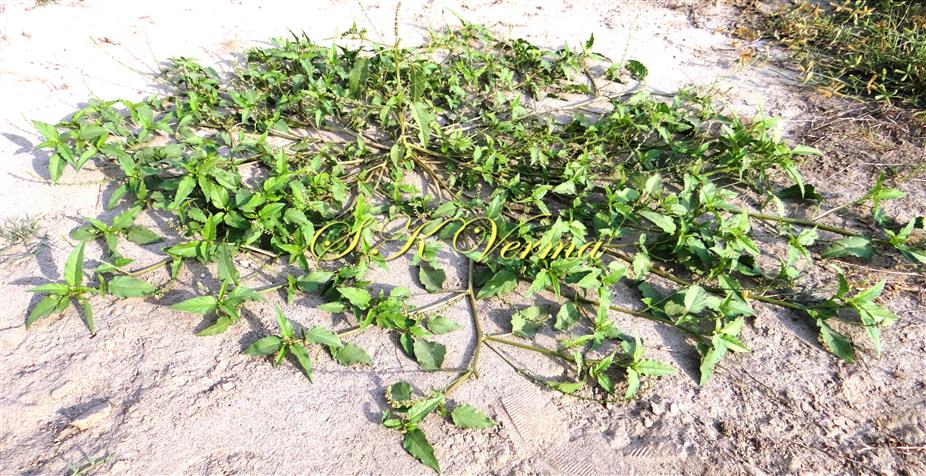

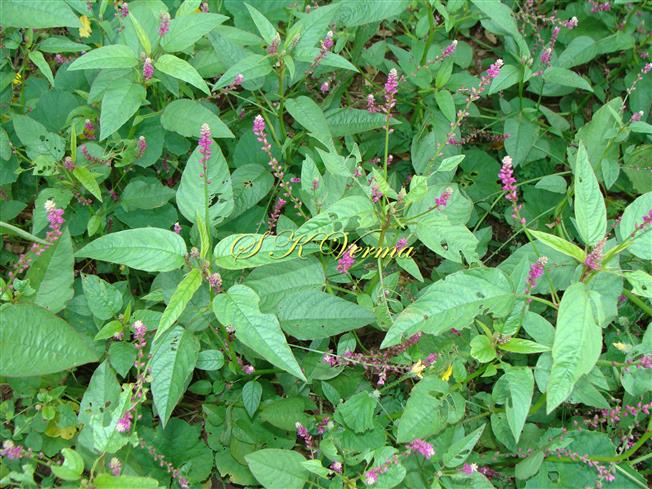
-DSC07140.jpg)
-DSC07126.jpg)
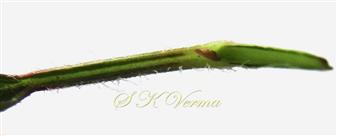
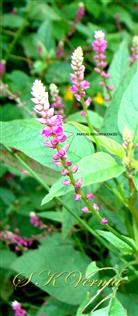

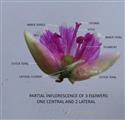
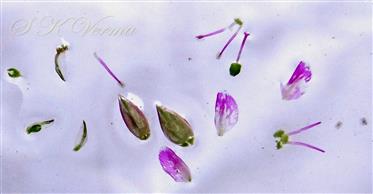




-DSC07140.jpg)
-DSC07126.jpg)


